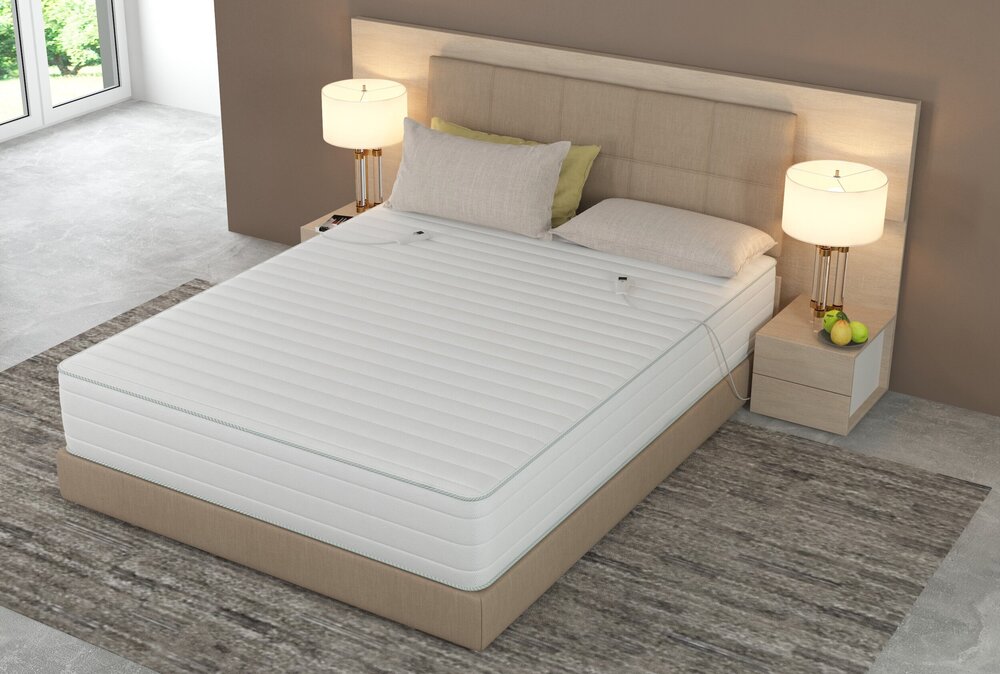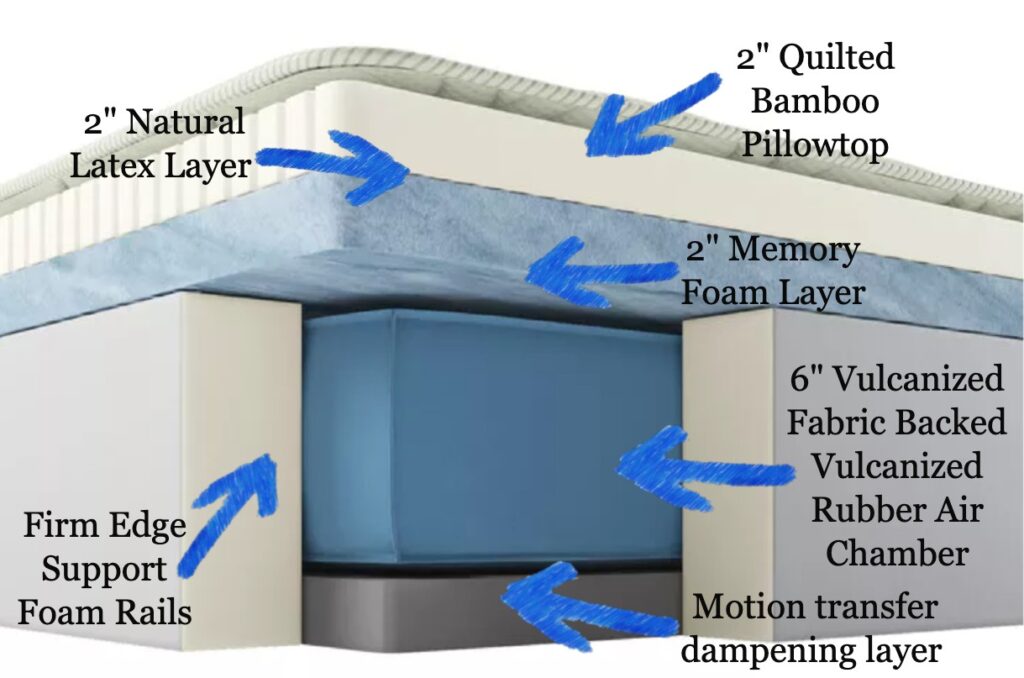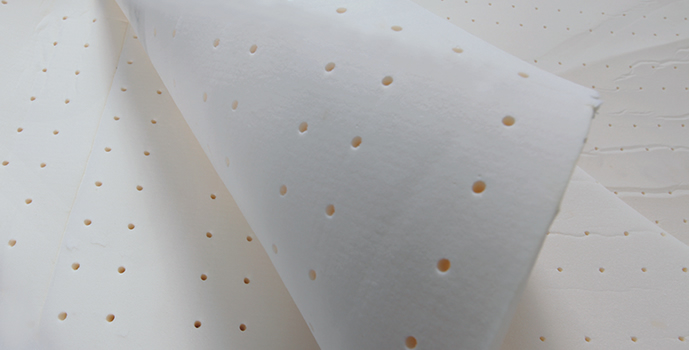Habitat Ascend Air Bed Review: Number Style Adjustable Air Bed With Natural Latex And Memory Foam
If you are considering an air bed and have been looking at number style mattresses, take a look at my review of The Habitat Ascend Air Bed, an adjustable air bed with dual remotes that includes latex, memory foam, and a pillow top section that is quilted for additional comfort and support. I evaluated and rated this digital number style bed option using my 10 point scoring system.
Pricing during our review process on the company’s site was $2299 for a queen, and $2399 for a king size mattress, and included shipping. You receive a 20 year warranty, which provides for 10 years free replacement cost for any replacement components.
With a digital air bed, there is a concern by consumers about the pump, hoses, and air chambers, but through the years I’ve found little evidence that this is an issue. This is likely because the air pump is a sealed unit, and usage is minimal with average pump operation time of 5-7 minutes per week.

Known for their excellent support and buoyant, flotation like feel, along with the ability to adjust each side of the mattress for firmer or softer feel using built in remote controls and sophisticated pump systems, number style air beds are hugely popular.
They are also popular for individuals who snore, have sleep apnea, back issues, and many other medical issues.
The Habitat Ascend Air Bed is manufactured by a company in Baltimore, Maryland, by a small team that manufactures them on site, compiling the components from their own local sources. The company manufactures their own pillow top quilt used as an outer covering in house, and when a customer places an order, each mattress is packaged and shipped to your door via FedEx or UPS, arriving in 3 boxes.
The system is easy to assemble, and the site included an assembly video and pretty decent instructions with your shipment. We setup our test sample in less than 20 minutes. One advantage to this kind of modular setup is that if you move, it’s easy to breakdown the mattress, pack it up, and reassemble it at your next residence. This added a lot of value in my review.
The Habitat Ascend Air Bed also incorporates a 2” layer of natural latex as well as a layer of 4lb. density memory foam built into its design, and appears to be the only digital, number style air bed featuring a layer of natural latex. The Habitat Ascend Air Bed is made with a plush and thick quilted bamboo top covering, which I found to be very inviting and comfortable, without being too soft.
A digital air bed offer the ability to precisely control the soft or firm level on separate sides of the mattress. The pump system that is attached to the system has two separate pistons, one for each side of the mattress, and they operate independently from each other.
Each remote operates the corresponding side, generally in a range from 0-49 mmHg, though some systems simply use a 10-50 reference range that doesn’t translate into measurable units.
Often, couples have very different requirements for comfort and support, and by sharing a bed that cannot be customized, many people end up in separate bedrooms! This option is a way to meet in the middle. The Habitat Ascend Air Bed
Number style air beds can be expensive, as high as $4-5,000 depending upon features, which can include heating and cooling equipment, sleep behavior mapping, and other features. Often, lower density foams that are not responsive or resilient are used to control costs.
The Habitat Ascend Air Bed was originally part of a 3 model lineup, but the Ascend version outsold the other two models which were eliminated. The 2″ natural latex and 2″ gel/memory foam layers seem to be exclusive to Habitat Furnishings, along with the zip-on and dry cleanable outer pillow top quilting piece.

How The Habitat Ascend Air Bed Performed In My 11 Data Point Test
My Objective Test Results: The Habitat Ascend Digital Air Bed Scored A 9.4 Out Of 10
I reviewed The Habitat Ascend Air Bed in a simulated bedroom environment with the mattress placed on a solid deck surface of platform bed in queen size. All of the data I collected was incorporated into the individual scores for each characteristic
1. Overall Comfort– initial feel, level of immersion, initial body contact experience, 9
2. Support– spine alignment, pain relief, pressure relief in 30 minutes or less 10
3. Solo Sleeper– overall impressions with comfort, ease of turning, back and side 9
4. Couple Experience- minimal sink in middle (1.5″), snugglers dream, quiet motion transfer 10
5. Edge Support– no sliding off, as experienced by 190lb test subject 10
6. Cooling Power: Surface temp before testing, 73F, After 30 Minutes lying on back, 81F- very good cooling, 9
7. Intimacy– supportive at center, minimal bounce, no collapsing in center 9
8. Bounce, Motion Transfer, And Liveliness– latex layer provides good uplifting feel very good motion transfer 10
9. Cost Value– less than number style digital air bed leading brands-10
10. Trial Period, Warranty, And General Customer Service Appeal 10
11. Shipping And Delivery Experience– ease of delivery, clean packaging, ship time, setup 9
Overall Rating Of The Habitat Ascend Air Bed: 9.4/10
Notes: Who got our sample? We donated our sample to Habitat Restore, part of Habitat For Humanity, located in Mandeville, Louisiana.
Inside The Habitat Ascend Air Bed
The Habitat Ascend Air Bed makes use of a few key ingredients The entire apparatus is contained within an exterior outer covering usually made with a zippered encasement, since in most cases, when you purchase an air bed, you will be buying it in modular kit form, following some simple instructions and assembling it piece by piece in your home.
You’ll likely have a set of stiff foam side rails which form the perimeter of the interior, inside of which are placed the air chambers that are adjustable, with hoses that snake to the outside, and attach either to an exterior pump unit, or a pump unit that is concealed inside of the bed.
The remote controls attach to the pump if they are hard wired, or can be wireless, in which case they communicate with the pump unit.
Above the air chambers and stiff side rails and head and foot rails, there may be one or more foam support layers, made of a variety of materials, or there may be no layers, depending upon the model and the cost.
Higher end digital air bed systems will often include a layer of memory foam, pure latex rubber, or other proprietary high density foam layers given unique names by the manufacturer, usually to conceal the fact that it is a pretty common or readily available material, but they simply don’t want other manufacturers to copy their product.
Higher end air beds offer many other luxurious features, including advanced memory settings, massage options, snore reduction technology, even warming systems and they can even be used on adjustable beds, now becoming extremely popular.
You can program an air bed so that is communicates with an app on your phone, it can track your sleep performance and auto-adjust if you’re a tosser and turner, and basically coach you into better sleep patterns. Pretty amazing. But, we think some of these features are overkill, and drive the price through the ceiling.
The air chambers, pump, and the remote controls are common features found on all adjustable air bed systems. What distinguishes each model within a brand has only to do with the ingredients between you and the air chambers beneath.
These layers are made from a variety of materials, generally referred to as “comfort layers”, and offer a different sleep experience from model to model. These layers of foam materials also greatly affect the cost, and can easily confuse you when you are shopping.
Ten years ago, most air beds were simplistically designed, consisting of one layer of material, in addition to the outer fabric encasement. The only way to control the firmness or softness of the mattress was to either pump the bed all of the way up, or dump all of the air until you were practically swimming in the mattress.
But with the advances in comfort layer technology, most number style air bed companies are using various specialized foam layers to improve comfort, pressure point relief, back pain, and to reduce tossing and turning, as well. The foam layer options are almost unlimited, with the advent of gel foam materials, graphite (charcoal) infused foam that disperse body heat, memory foam that disperses body weight uniformly, and latex, which offers a buoyant, lively feel.
The Habitat Ascend Air Bed combines two layers of specialized components and strategically places them above the natural rubber air chambers. By using a high quality layer of gel infused memory foam for pressure relief and to give you a “snuggled effect”, you’ll settle into their mattress just the right amount, without feeling trapped.
Above, their springy layer of natural latex offers a little bit of bounce and springiness that makes turning effortless, reducing the number of times you wake up at night. At the very top, Habitat incorporates a quilted top piece using a thin layer of resilient HD foam and a bamboo outer covering, for a clean, natural, and sumptuous finish.


A variety of comfort layer foam materials are available that you can specifically inquire about, including high density foams (similar to those used in home furnishings and in conventional mattresses as support layers), memory foam (used for pressure relief and weight distribution), and natural latex. Habitat Furnishings offers a lot of technical information on their web site about their three model lineup.

There’s a few key considerations regarding the structural elements inside of The Habitat Ascend Air Bed that a worth understanding.
From the ground up, a typical adjustable air bed is constructed in a layer cake fashion. The outer encasement or covering is usually made like a gift box, with a bottom “container” type of construction, and a top piece that either zips on or attached somehow to the top of the bottom piece.
The fabric used in the outer cover should be a breathable material, such as cotton or bamboo, though it’s ok to have a little rayon in the weave, I think, since that usually provides some stretch and give to the covering. Passive ventilation is important in an air bed, since a lot of foam layers are used, which can sleep warmer if the proper outer cover is not breathable.
Hot sleepers need to be looking at breathable materials that passively move heat away from the bed. Materials like Tensel, for example. A naturally based fiber that is proven to wick away moisture and heat, we are fond of referring to it in the business as “air conditioning by the yard”.
Generally, a perimeter, or outer edge, of a firmer foam material is used to provide the “exoskeleton”, in which everything sits inside. This outer edge is also important, since you rely on it to provide support to get in and out of bed, put your shoes on, and for those with physical limitations, allows for easy transfer in and out of bed. A good digital air bed will often use at least a 2 lb. density foam rail system to provide the edge system.
Inside the edge system is where you fill typically find the air chambers, which when controlled by the pump, allow the bed to range in comfort levels from resilient and firm to soft and nest like, merely by adjusting the handheld controller. Your best bet with air chambers? Make sure you’re buying fabric backed, vulcanized rubber air chambers.
I don’t recommend purchasing an adjustable air bed with PVC, Nylon, or other plastic air chambers. These materials do not stretch well at higher settings, and at lower pressures, will swallow you into a pit of despair. Vulcanized rubber will stretch at higher settings, and still be supportive and supple while at softer settings.
Generally, above the air chambers, you’ll find the foam layer options we talked about, each providing a unique feel and personality for every model.
If you are a side sleeper, or if you are seeking pressure point relief for example, say from hip or shoulder pain, you’d likely want to find an air bed using a memory foam layer, along with some supportive layers placed below or above this layer. The memory foam we recommend- all across the board- is a 4 lb. density foam. Ask about it, insist on it.
The inferior, most commonly used 2-3 lb. density memory foam won’t last more than five years. Also, because memory foam responds to body heat, it becomes more moldable and flexible after you’ve been lying on it a bit, and many people fall in love with that wrap around your body and cradling sensation.
Let’s say you like a buoyant, livelier mattress, without that sinking sensation, but like the softer, giving feel of a bed. You’ll definitely want some latex, preferably natural or at least a blend, and at least a layer that is 2″ inches thick, situated directly beneath the outer quilted top or encasement material.
Habitat Ascend Air Bed: Components Used, Features And Benefits
ILD is an acronym for Indentation Load Deflection, and refers to the amount of weight occupying one square foot that will compress a layer of foam (generally a 4″ thick sample) 1 inch. It’s a general guideline for density and degree of support and firmness.
20-24 ILD Very Soft- Good for very top layers, the interior of a pillow, or inside of a quilted pillowtop.
25-30 ILD Soft to Medium feel, ideal for the top of direct body contact layers, allows a comfortable amount of sink or immersion, and cushiness.
31-40 ILD Medium To Firm feel, ideal for lower layers, providing support. Don’t go higher than 36 or so for pieces in an air bed for the simple reason that the more you stack firmer layers of foam on top of the air chambers, you can begin to diminish the ability to detect adjustments when you remove or add air to the chambers.
The ILD quantification is most commonly used for those foam layers or components that are given hyped-up names like “Plushfoam”. Regardless of the name, if you can get an ILD on the material, it will tell you the general characteristics of the foam. Rule of thumb: high density foam with an ILD range of 27-35 tend to last the longest, are more durable, and resist splitting, stretching, and cracking.
HD foam, or polyurethane foam, is one thing, but memory foam is quantified a bit differently. the rating of density and quality for memory foam (also called visco-elastic foam) being characterized in density, meaning one cubic foot of a given sample weighs x pounds.
For memory foam layers, we recommend finding memory foam that is at least 4lb density rather than 3 lb, since the 4lb variety is a bit more durable and tends to resist cracking and splitting. It is not noticeably firmer, and will last longer in the 4lb range. Also, if you like a firmer feel up top and still like the memory foam sensation, ask for a 5 lb. density material.
If you are looking for an air bed that is uplifting and buoyantly supportive, a bit livelier and springier, definitely seek out a model with natural latex, or softer layers of HD foam, like a high density (HD) foam that is around 25 ILD , or an HR (high resiliency) foam layer, that has flex and a more elastic feel, roughly in the 22-25 ILD range.
I personally like the feel of natural latex, since it is springier, and it’s also completely chemical free and does not off gas fumes or odors.
Habitat Ascend Air Bed: Pump And Remote Controls
Basically, you can buy an air bed that has either hardwired remotes, or wireless. The considerations there are really personal choices, though with a wireless unit, you need to occasionally change batteries, and if you operate other media equipment like a TV, there may be remote hunting at night, as I often have that problem with my wandering remote controls.
Many brands provide a hardwired remote, which you can trace back with the cord, and most models out there offer a readable LED screen, so you can punch in your desired setting, find it, and lock it in with a memory button, so you can reset it as required.
Remember that it is normal for a digital air bed to lose a few points of pressure during the day and the purpose of the memory setting is so that you can tap it, and bring the bed right back to your comfort zone.
Shipping And Assembly Of Your Habitat Ascend Digital Air Bed System
Typically, most air beds are shipped to you either partially assembled, or fully assembled, generally depending upon the vendor. In fact, a digital air bed is highly modular, which is an asset, I think. Down the road, if you are out of warranty and need a replacement layer of foam, you only need to replace that one component, and you’re not stuck with replacing an entire mattress.
Also, assembling an air bed gets you highly familiar with the working components, which I like. Unlike conventional innerspring mattresses, a digital air bed system allows you to handle and understand the structure of the bed, making it easy for you to go back in when required, should you ever need to troubleshoot a problem.
Generally, however, digital air beds are fairly bulletproof, and most suppliers have worked out the kinks with components and can deliver a bed that offers comfort elements that are durable, long lasting and have been used in the bedding industry for many other kinds of mattresses.
Habitat Ascend Air Bed: Pricing, Industry Comparisons, And Value
A decent air bed can vary widely in price, from under $1000 for a basic, entry level model, to over $6,000 for a more sophisticated model from the most popular brands, with top of the line components and a luxurious outer covering. The top of the line model might feature a layer of memory foam or as other layers as we mentioned at the top of this article, and some other support foam layers that are designed to add some cushion and aesthetic qualities to the bed.
Also, I think a decent air bed should offer a moderately quilted top, without too much filler, otherwise you’re again separating yourself too far from the functional abilities of the air chambers beneath you. Too much piling on of material above the air chambers, and you begin to lose the ability to detect subtle changes in softness and firmness.
Also, ideally, you want to purchase an air bed that allows you to swap positions of the various support layers, so that you can “customize” your sleep surface. Be wary of any air bed that is sewn shut so that you can’t get inside of it. A zippered, removable outer covering allows you to remove and replace internal parts, or the outer covering itself, should you ever need to do so. The more “modular” you can make your air bed, the better off you will be during the long haul.
I’d say, after reviewing many different air bed companies, that a reasonably priced air bed system will run anywhere from $1400-$3000, depending upon the ingredients. If you want two premium layers such as memory foam and natural latex, expect to pay around $2800-$3000. If you’re paying $4,000-$5,000, understand what it is you are paying for by researching the individual support layers and the outer covering. Obviously, if you want a cashmere fabric on top, it’s going to cost you more.
trial periods, warranties and return policies
With the purchase of a Habitat Ascend Air Bed, you receive a no questions asked 90 day trial, and in the event you need to return the mattress, there is no pocket risk for you, a feature I like. Air beds, though often made with foam layers that can be moved around allowing you to change the feel of the beds, involve some assembly, and if you are moving to an air bed from another kind of mattress, there may be a slight adjustment period. You need to give some time, say two weeks, to allow your body to adapt to the unique floating and buoyant sensation that only an air bed can deliver.